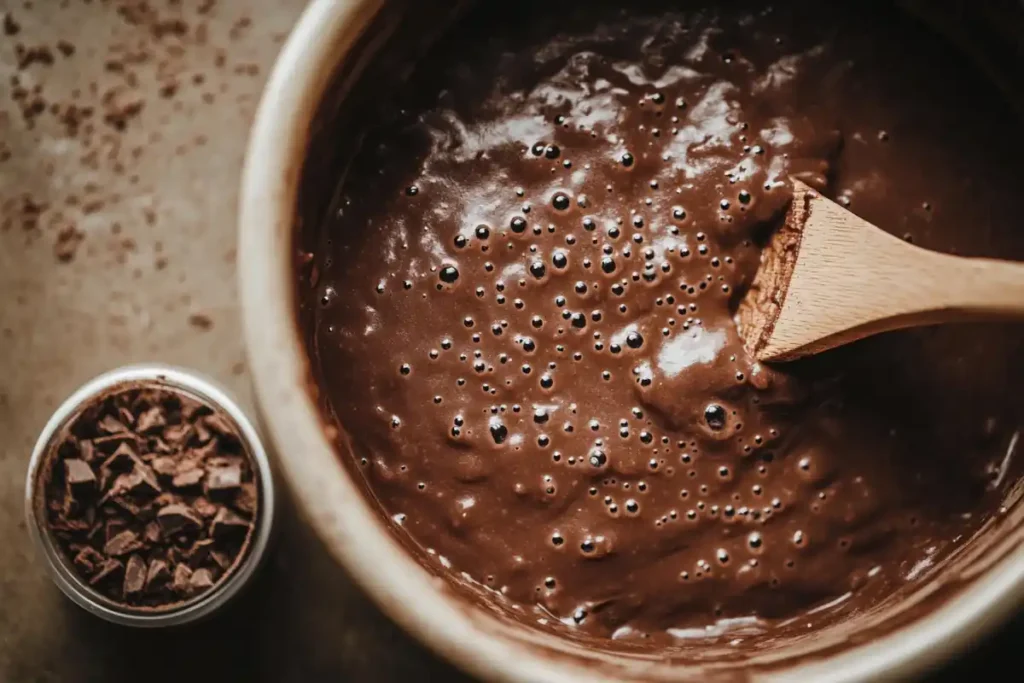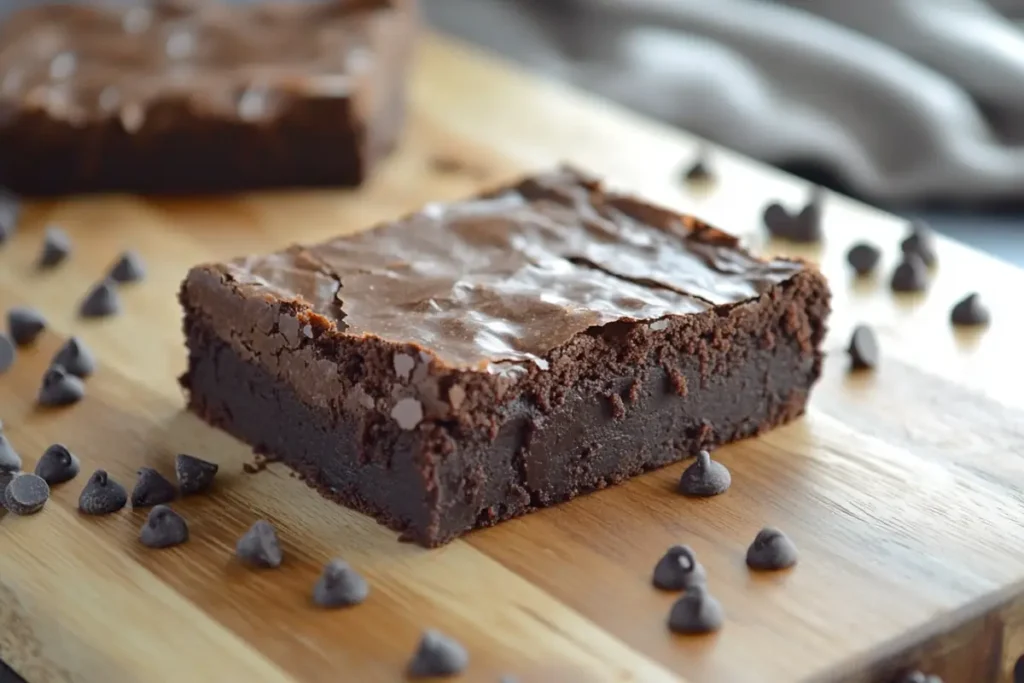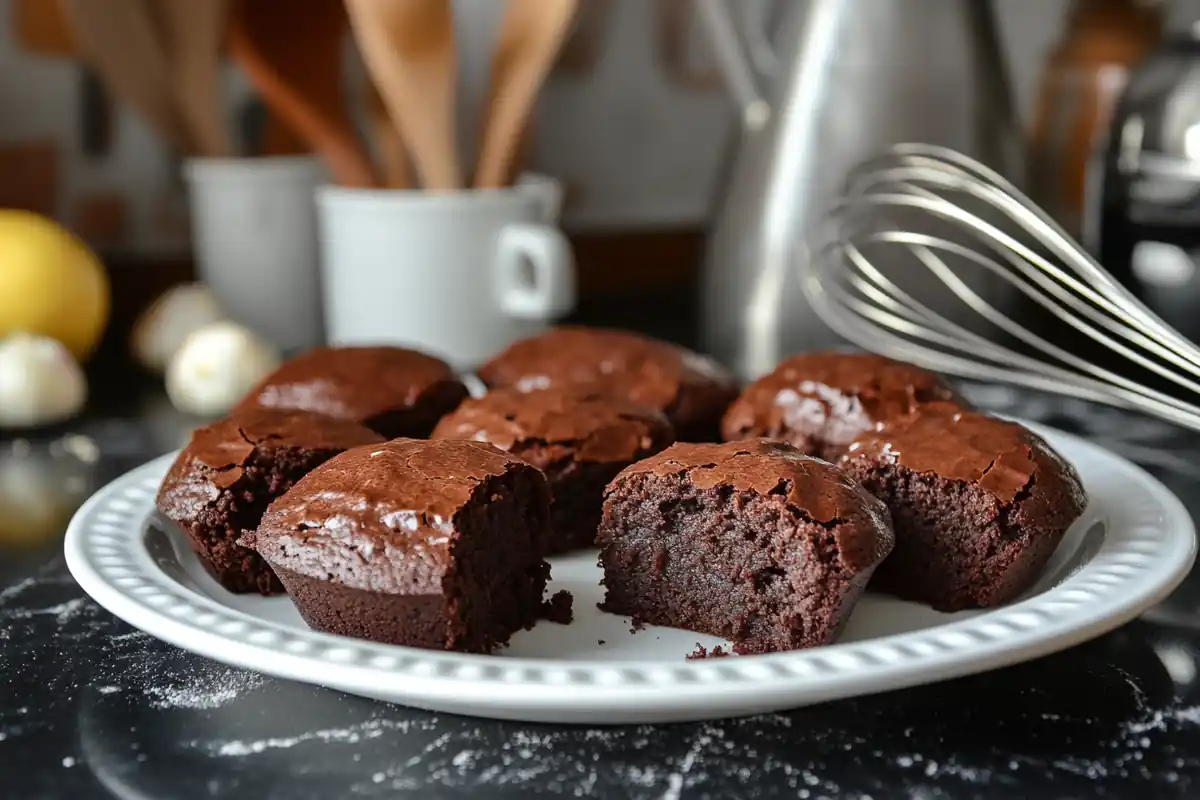What is baking powder used for in brownies? This common baking question often arises when home bakers aim for the perfect brownie texture—cakey, fudgy, or somewhere in between. Baking powder plays a vital role in determining how brownies rise and develop their structure. Some recipes omit it for a denser bite, while others rely on it for a lighter, fluffier texture
1: Understanding What Baking Powder is Used for in Brownies
Brownies come in a variety of textures—some are fudgy and dense, while others are light and cake-like. But what is baking powder used for in brownies? This essential ingredient plays a crucial role in determining how brownies rise and develop their structure. In this section, we’ll break down what baking powder is, why it’s important in baking, and how it differs from baking soda.
What is Baking Powder?
Baking powder is a chemical leavening agent that helps baked goods rise. It consists of three main components:
- Baking soda (sodium bicarbonate) – The base that produces gas when activated.
- An acid (such as cream of tartar) – Reacts with the baking soda to create carbon dioxide bubbles.
- A moisture-absorber (like cornstarch) – Prevents the acid and base from reacting prematurely.
When combined with liquid and exposed to heat, baking powder produces gas, creating tiny air pockets in the batter. These air pockets help the batter expand, leading to a lighter, airier texture. This reaction is what makes baking powder essential in recipes that require some lift—like cakey brownies.
Why Baking Powder is Important in Baking?
The main job of baking powder is to provide structure and lift. Without it, baked goods like cakes, muffins, and some types of brownies would turn out flat and dense. Here’s why baking powder matters in brownies:
- It creates a softer texture – The tiny bubbles formed during baking give brownies a more tender crumb.
- It controls density – Adding baking powder makes brownies cakier, while omitting it results in a fudgier texture.
- It ensures even rising – Baking powder helps prevent brownies from being too dense in some areas while airy in others.
If you’ve ever baked brownies and found them too heavy, adding baking powder could be the fix you need!
Difference Between Baking Powder and Baking Soda
Many people confuse baking powder with baking soda, but they are not the same. Here’s how they differ:
| Feature | Baking Powder | Baking Soda |
|---|---|---|
| Contains Acid? | Yes (includes an acid like cream of tartar) | No (requires an acidic ingredient to activate) |
| Reaction Process | Works on its own when mixed with liquid and heat | Needs an acid (like vinegar or yogurt) to react |
| Best Used In | Brownies, cakes, muffins | Cookies, some brownie recipes, and recipes with acidic ingredients |
For what is baking powder used for in brownies, the answer depends on the type of brownie you want. If you’re making fudgy brownies, baking soda or no leavening agent at all may work. If you prefer a cakier brownie, baking powder is the way to go.
2: What is Baking Powder Used for in Brownies’ Texture?
The texture of brownies is one of the most debated aspects among dessert lovers. Some prefer them dense and fudgy, while others love a soft, cake-like bite. But what is baking powder used for in brownies exactly? It primarily affects the leavening process, which in turn influences the texture, structure, and even the final appearance of your brownies.
Leavening and Texture Transformation
Baking powder works by releasing carbon dioxide gas when mixed into the brownie batter and exposed to heat. These tiny gas bubbles create air pockets that expand, lifting the batter and giving it a lighter, airier structure. Without this leavening action, brownies would turn out much denser.
Here’s how baking powder influences brownie textures:
- Fudgy Brownies – Contain little to no baking powder, relying on a higher fat-to-flour ratio for a rich, dense texture.
- Chewy Brownies – May include a small amount of baking powder, which introduces slight airiness while maintaining a chewy bite.
- Cakey Brownies – Require more baking powder to create a well-risen, soft, and fluffy texture.
If your brownies turn out too dense when they should be fluffy, check the amount of baking powder you’re using—it could be the key to achieving the perfect texture.

Impact on Flavor and Appearance
Baking powder doesn’t directly affect the taste of brownies since it has a neutral flavor, but it does play a role in how they look and feel:
- Rise and Structure – Brownies with baking powder will rise higher and appear more structured, whereas those without it tend to be shorter and compact.
- Crumb Texture – A properly balanced amount of baking powder ensures an even, delicate crumb, making each bite light and satisfying.
- Moisture Retention – Brownies with baking powder often retain moisture better than those without, preventing them from becoming overly dense or dry.
However, too much baking powder can backfire. It may cause brownies to rise too quickly and collapse in the middle, leaving an uneven texture. To prevent this, always measure accurately and mix your batter gently to avoid deflating the air bubbles.
3: Types of Brownies and the Role of Baking Powder
Cakey vs. Fudgy Brownies
The great brownie debate often boils down to this: cakey or fudgy? Baking powder is a deciding factor here. Cakey brownies owe their fluffier texture to the presence of baking powder, which introduces airiness. These brownies feel lighter and resemble a cross between a cake and a dense loaf.
In contrast, fudgy brownies steer clear of leavening agents like baking powder. Instead, they rely on the fat content from butter and chocolate, creating a rich, dense texture. These brownies often feel indulgent, with a melt-in-your-mouth quality that’s hard to resist.
When deciding whether to include baking powder, think about your texture preference. For hybrid styles, using a small amount can strike a balance between airy and fudgy.
Adjusting Baking Powder for Desired Texture
Want to experiment with textures? Adjusting the quantity of baking powder can help. For a slightly cakier texture, add half a teaspoon to your favorite recipe. For an ultra-cakey result, try a full teaspoon. Just be cautious—overdoing it can lead to an overly puffy or spongy bake.
If you’re avoiding baking powder entirely, alternative methods like whipping egg whites or increasing butter can also create unique results. Each tweak influences how the brownie feels on your palate.
For more creative brownie ideas, check out this M&M Cookie Dough Brownie Recipe. It combines a soft base with layers of exciting textures.
4: Baking Powder in Combination with Other Ingredients
Interaction with Cocoa Powder and Acids
When using baking powder in brownies, its interaction with other ingredients like cocoa powder and acids plays a pivotal role. Cocoa powder, especially natural cocoa, is slightly acidic. This acidity can activate baking soda, but in the absence of baking soda, baking powder steps in as a self-sufficient leavening agent.
For recipes relying solely on cocoa powder for chocolate flavor, baking powder ensures the batter rises without altering the taste. The neutral nature of baking powder means it works seamlessly with non-acidic ingredients, making it versatile in brownie recipes.
Balancing Baking Powder with Fat and Sugar
The fat and sugar in brownies also influence how baking powder works. Higher fat content, such as butter or oil, can weigh down the batter, so baking powder is needed to provide lift. However, too much baking powder can lead to an overly puffy texture, which might feel out of place in a rich dessert like brownies.
Sugar, meanwhile, adds sweetness but also impacts texture and moisture. Baking powder complements sugar by ensuring the batter doesn’t collapse during baking. This synergy helps create a well-structured brownie that isn’t too dense or too airy.
For a twist on classic brownies, explore our Protein Brownies Recipe. These recipes add a nutritional boost without sacrificing texture or flavor.
5: Common Issues and Fixes When Using Baking Powder in Brownies
Overusing or Underusing Baking Powder
Ever wondered what is baking powder used for in brownies and how much to use? While it’s a handy ingredient, too much baking powder can lead to brownies that rise excessively and then collapse, resulting in uneven texture. Overuse may also leave an unpleasant metallic aftertaste.
On the flip side, underusing baking powder—or skipping it entirely—can make your brownies overly dense and flat. If you aim for fudgy brownies, this might be ideal, but for a balanced texture, measure carefully. A general rule of thumb is to use about ½ to 1 teaspoon of baking powder per cup of flour.
Troubleshooting Texture Problems
If your brownies turned out too dense or crumbly, the issue might lie in the ratio of baking powder to other ingredients. To fix this, ensure your ingredients are measured accurately and your batter isn’t overmixed, which can deflate the bubbles created by baking powder.
Temperature also plays a role. Preheat your oven fully before placing the brownies inside. An uneven temperature can disrupt how baking powder activates, leading to inconsistent results.
For more helpful tips and creative recipes, explore Successfully Recipes for inspiration.

6: The Science Behind Baking Powder in Brownies
How Baking Powder Works in Baking
To understand what is baking powder used for in brownies, it helps to dive into the science. Baking powder is a chemical leavening agent that releases carbon dioxide gas when combined with liquid and heat. This reaction creates air pockets, causing the batter to rise.
In brownies, this rising action directly impacts the final texture. The amount of gas released determines whether your brownies turn out light and airy or maintain a denser, fudgier consistency. Single-acting baking powder starts working immediately after mixing, while double-acting baking powder reacts in two stages—first when mixed with wet ingredients and then during baking.
Why the Right Amount of Baking Powder Matters
Using too much baking powder can disrupt the balance of your brownie batter, causing the mixture to puff up excessively and then collapse. On the other hand, too little baking powder can lead to brownies that are overly dense and lack structure.
The right amount of baking powder depends on the texture you’re aiming for. Cakey brownies typically use about 1 teaspoon of baking powder per cup of flour, while fudgier versions often omit it entirely. If you’re experimenting with your recipe, always start with a small amount and adjust as needed.
For more insight into achieving the perfect balance, check out our M&M Cookie Dough Brownies, which highlight texture variations brilliantly.
7: Baking Powder Substitutes and Alternatives in Brownies
Can You Replace Baking Powder in Brownies?
Yes, you can replace baking powder in brownies, but the substitutes depend on the recipe. Baking soda is the most common alternative, but it requires an acidic ingredient, like lemon juice or yogurt, to activate. For a similar texture to what baking powder provides, mix ¼ teaspoon of baking soda with ½ teaspoon of cream of tartar.
Other options include self-rising flour, which already contains baking powder, or whipped egg whites, which can introduce air and provide some lift.
When to Skip Baking Powder Altogether
If you’re going for a dense, fudgy brownie, you might skip baking powder entirely. The richness of butter and chocolate, combined with the binding properties of eggs, is enough to create a moist and chewy dessert.
However, if you omit baking powder but still want a hint of lift, try incorporating air into the batter by whisking the sugar and eggs thoroughly. This method helps achieve a slightly lighter texture without the need for chemical leavening.
For more creative twists on brownies, explore our Protein Brownie Recipes, which showcase innovative ways to tweak traditional recipes.
8: FAQs About Baking Powder in Brownies
Can You Skip Baking Powder in Brownies?
Yes, skipping baking powder in brownies is possible, especially if you prefer a dense, fudgy texture. Many traditional recipes don’t include baking powder because the eggs, butter, and sugar provide enough structure and richness. However, for brownies with a light, cake-like texture, baking powder is essential for creating the desired rise and softness.
If you’re still asking what is baking powder used for in brownies, its primary purpose is to add lift and create an airy texture. Without it, the result will likely be flatter and denser.
How Much Baking Powder Should You Use?
The amount of baking powder to use depends on your recipe and the texture you’re aiming for. Typically, ½ to 1 teaspoon per cup of flour is enough to achieve a balanced rise. Overdoing it, however, can cause your brownies to rise too quickly, leading to cracks or even collapse during baking.
Can You Substitute Baking Soda for Baking Powder in Brownies?
Yes, but with caution. Baking soda requires an acidic ingredient (like buttermilk or lemon juice) to activate. If your recipe doesn’t include one, you may need to adjust the ingredients to ensure the substitution works. Generally, ¼ teaspoon of baking soda plus ½ teaspoon of cream of tartar can replace 1 teaspoon of baking powder.
9: Pro Tips for Using Baking Powder in Brownies
Always Measure Accurately
Accurate measurements are critical when using baking powder in brownies. Too much can result in overly puffy brownies with an unpleasant aftertaste, while too little might leave them flat and dense. Using a leveled measuring spoon ensures consistency every time.
Combine Ingredients Properly
Mixing the batter correctly helps baking powder do its job. Always sift dry ingredients, including baking powder, to distribute them evenly. This step prevents clumping and ensures a smooth, uniform batter. Additionally, avoid overmixing, as this can deflate the bubbles baking powder creates, reducing the lift.
Experiment for Desired Texture
If you’re wondering what is baking powder used for in brownies and want to fine-tune your recipe, don’t hesitate to experiment. Start with a small amount and adjust according to your texture preference. Cakey brownies benefit from more baking powder, while fudgy ones need less or none at all.
For more baking inspiration, check out this Protein Brownie Recipe, which creatively incorporates baking powder for unique results.

